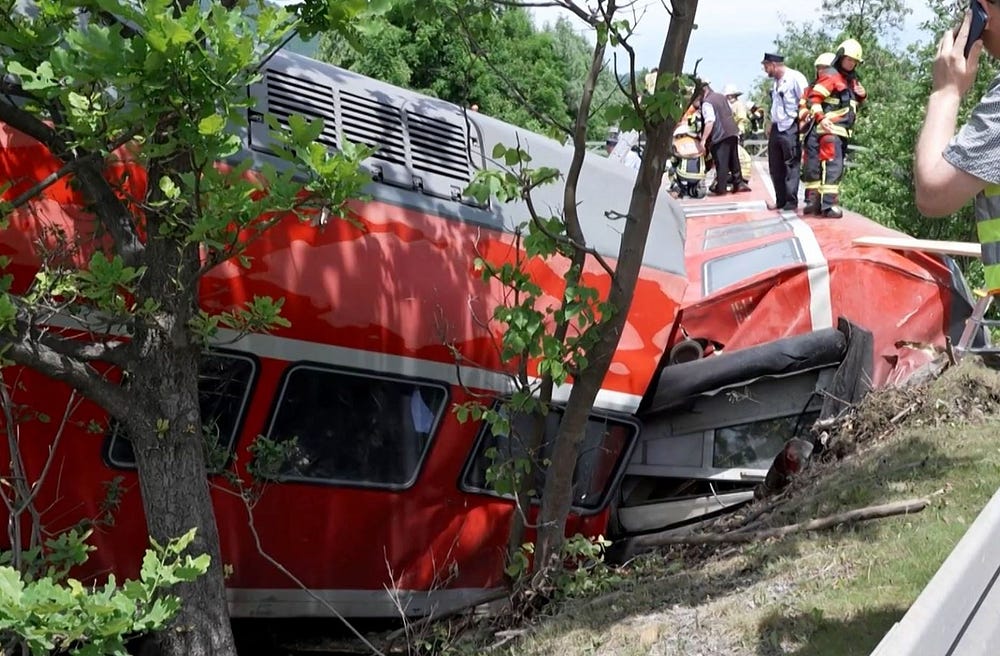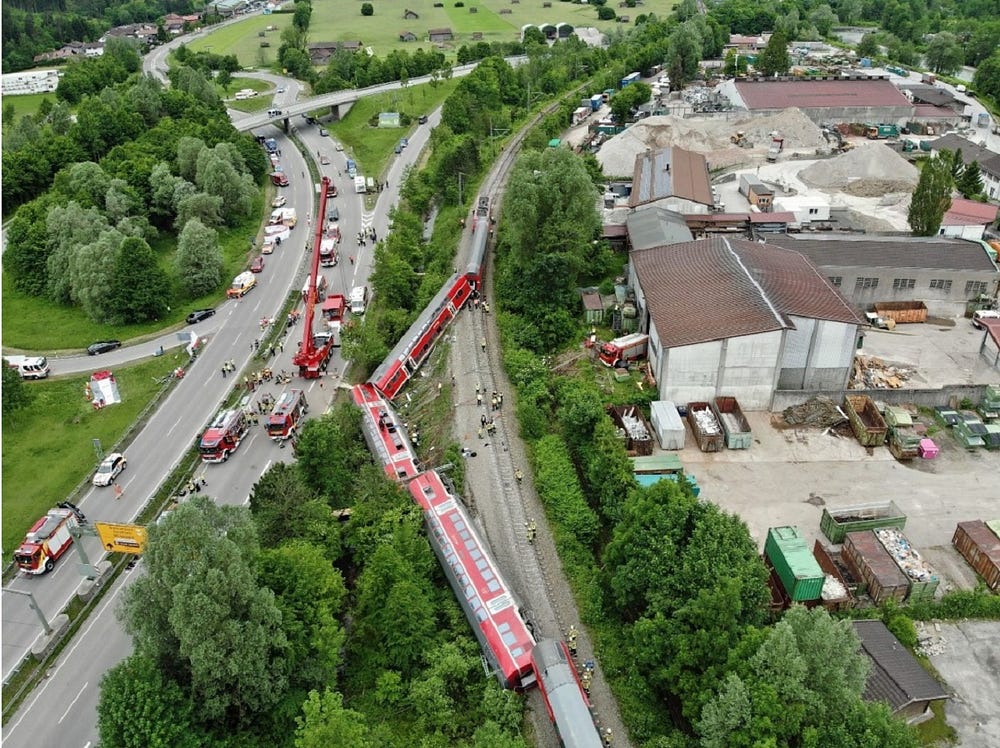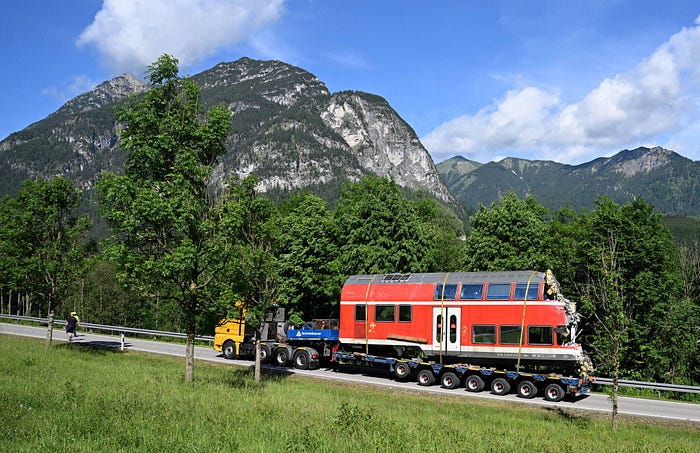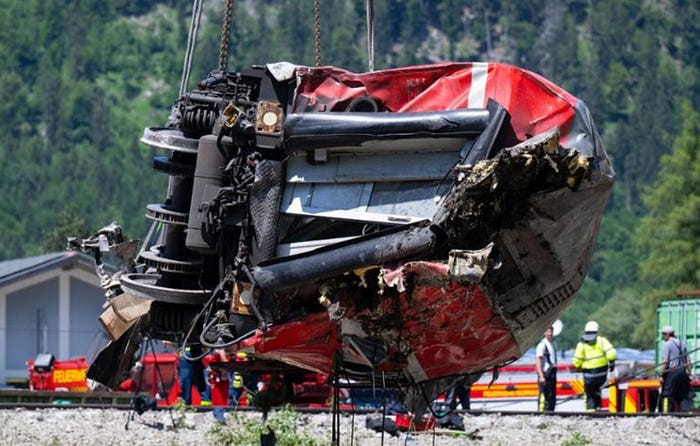
Background
Burgrain is a village of 2065 people (as of 2018) in southern Germany, located in the federal state of Bavaria 2.7km/1.7mi north of Garmisch-Partenkirchen and 44km/27.5mi southwest of Bad Tölz (both measurements in linear distance). The village is commonly considered part of Garmisch-Partenkirchen, despite being located a few kilometers away.

The village lies on the München-Garmisch-Partenkirchen rail line, an electrified partially double-tracked main line connecting Munich with Garmisch-Partenkirchen, a popular tourist destination on the Austrian border. The line opened in sections between 1854 and 1889, originally being focused on freight before the connection to today’s southern terminus shifted the focus to passenger services. The line is mostly used for regional passenger trains today, reaching speeds of up to 140kph/87mph.

The Train Involved
Train number 59458 was a midday service on the RB 6-line (“Regionalbahn 6”, Regional Train 6) intended to depart Garmisch-Partenkirchen for Munich at 12:07pm. The train consisted of DB (German national railway) Class 11 number 035 electric locomotive and five Mark 4 DWA bilevel passenger cars. Four of the cars were standard bilevel passenger cars while the fifth car, which led the train at the time of the accident, was a so-called cab car. Cab cars are passenger cars fitted with a driver’s cab at one end, allowing remote control of the locomotive when the train is reversing. They are a popular choice in passenger traffic as they allow a train to change direction without requiring the locomotive to be moved around to the other end of the train.

The leading cab car was a type 766.0, an all second-class bilevel cab car with air conditioning introduced in 2004. The type measures 27.27m/89.5ft in length at an empty weight of 52 metric tons and can carry 91 seated passengers at up to 160kph/99mph. The standard bilevel cars behind it each measured 26.8m/88ft in length at an empty weight of 50 metric tons and could seat up to 106 passengers depending on their configuration (pure second-class cars have more seats, those with partial first class interior less). The exact number of passengers on board at the time of the accident is unknown.

The Accident
The RB 6 leaves Garmisch-Partenkirchen station at 12:14pm on the third of June 2022, running a delay of just 7 minutes. It takes the train approximately 2km/1.25mi to accelerate to the local top speed of 100kph/62mph. The first scheduled stop would be Farchant, 5km/3mi down the line, but the train will never get there. Shortly after departing it navigates a long right hand curve just south of Burgrain before diving into a slightly tighter left hand turn. The leading end of the train then suddenly derails just beyond the halfway point of the turn, departing the tracks to the right hand side and pulling the rest of the train with it. The couplings between the cars break apart as cars 2 to 4 fall over, with the right hand side of car 3 suffering a large tear as it slides over an uprooted support pole for the overhead catenary. Cars 1 and 5 remain somewhat aligned with the destroyed track, as does the derailed locomotive, while cars 2–4 have slid down the embankment towards the nearby B23 federal main road. Five passengers die in the derailment, another 78 people suffer (in 16 cases severe) injuries.

Aftermath
The train had come to a rest right next to a major road in the area, with car 3 even almost touching the guardrail as it bridged a small creek, which at least allowed responders to quickly access the site in large numbers. A commander of Garmisch-Partenkirchen’s fire department had actually been passing the site right as the train derailed (the department’s report says the train “fell on his feet”), leading to an extremely fast and precise alert being issued. Him and two firemen who were with him, intending to pick up a firefighting vehicle from being serviced nearby, are the first outside responders to tend to the passengers, aided by German soldiers who happened to be on the train. Further responders start arriving within 5 minutes of the derailment, bringing actual equipment which allows the train cars to be secured against movement on the 8m/25ft hillside between the rail line and road. Over 600 responders are involved in the rescue-effort by the time the train is declared empty an hour after the derailment, with two dead and three people missing. The three missing passengers are later found beneath one of the train cars as those are recovered, raising the loss of life to 5.

The first theory, that the train driver was speeding, is quickly rejected. Instead, investigators notice that several of the concrete sleepers (the beams connecting the two rails to each other) had become detached from the outside rail ahead of where the train derailed. It becomes clear that the lateral forces caused by the heavy train cars going through a turn overwhelmed several sleepers, causing them to fail. This led to the outside (right hand) rail moving outward as the train drove over it, causing the train to derail off the left hand rail as the track width of the track increased. Subsequent intact sleepers narrowed the gauge again, forcing the train back to the left. The suddenly reintroduced resistance from the left hand rail pushing against the side of the left hand wheels didn’t allow for the train to merely “retrack” itself, instead the right hand wheel “climbed over” the right hand rail, with car 3 being the first to head off the rails and into the ditch. It caused car 2 to tip over as its rear end got dragged towards the ditch, while an overhead catenary support pole ripped a sizable tear into car 3’s side.

The recovery of the train cars posed a whole challenge of its own to the workers, for the simple fact that the bilevel cars involved are really really big. And the accident had left all but one of them in a condition and/or position that made them unable to be towed away on tracks. They’re among the largest rail cars in Germany, and are significantly larger than what would fit down the roads on a flatbed. Thus, since the cars were beyond saving anyway, the DB made the decision to have the 4 stranded train cars removed in 8 pieces. A large excavator fitted with hydraulic “jaws” usually used for demolition work was brought in, cranes lifted the train cars off the rail line and they were then cut in half, enabling them to be removed. The half-cars were then stored in a nearby quarry pending the conclusion of the investigation.

Having removed the train from the site allowed improved access to what was left of the rail line (along with recovery of the final 3 victims’ bodies), with focus continuing to be on the failed sleepers. All the sleepers that had failed had previously passed the standard visual inspection procedures, allowing them to remain in place. However, samples taken from inside the sleepers, either by drilling or from where they broke during the derailment, revealed that several of them had suffered extensive internal damage from a phenomenon referred to as “Concrete-Cancer”. The issue, officially referred to as ASR (Alkali-Silica-Reaction), is a chemical reaction which causes the concrete to expand, leading to cracks forming and spreading through the concrete object. The cracking, in the process, obviously weakens the concrete. The phenomenon occurs when the highly alkaline cement in the concrete reacts with silicic acid which is usually introduced when quarz or calcium hydroxide is mixed into the concrete.

Please note: I tried my absolute best with the following explanation, there might still be an error that slipped in in the translation.
In greatly simplified terms, turning cement into concrete involves mixing (usually) 1/5 cement with 4/5 sand (and sometimes gravel) while also adding water. The water doesn’t evaporate (hence why one usually says concrete is “curing” rather than ”drying”), it instead goes through a chemical reaction turning the powdery cement into a glue-like substance, which absorbs the water. The absorbed water is then split into its chemical ingredients (oxygen and hydrogen) as the concrete begins to harden over several hours. One of the resulting chemicals is Alkali-hydroxide which reacts with Silicon dioxide, creating calcium silicate hydrate, a gel-like substance (typically yellow-ish in color) which begins the swelling-process. By that point the concrete has already properly cured, and is thus everything but flexible. The expansion pressure thus leads to cracks as the expanding gel forces the concrete out of the way, eventually bringing cracks to the surface where outside moisture is absorbed. This “refuels” the reaction, leading to even more expansion which leads to yet more cracking.
These cracks weaken the concrete until it eventually fails to provide sufficient rigidity for its purpose. The issue is well known and usually regulated through both the choice of aggregates mixed with the cement and regular inspections to spot damage early enough for repairs/replacement of the damaged piece. Early loss of pieces or even full buildings still occurs though, such as the “Lachswehrbrücke” in Lübeck, Germany, which had to be demolished just two years after opening in 1966. It had been constructed with such poor quality concrete that cracks spread faster than anticipated, enabled by the river providing ample moisture to accelerate the process. Similarly, thousands of kilometers of rail line in east Germany required replacement in the 1970s and 1980s, an issue later traced to the usage of unfit gravel from the Baltic sea for concrete sleepers and catenary poles. Generally, the more exposed a concrete structure is to moisture/water the bigger an issue ASR will be, which is why rail lines and motorways are bigger “hotspots” than, say, the floor in a building.

The DB’s maintenance-division had been well aware of ASR-related issues with concrete sleepers, which is why the presence and degree of surface cracking and the detection of the yellow-ish substance along the cracks were major parts of the inspection procedures. The examination of the sleepers from the site of the accident showed that those procedures had simply been insufficient, though, with extensive and, as it turned out, catastrophic cracking occuring within the sleepers without the outside surface looking nearly as bad/degraded. This was further escalated by some of the sleepers showing advanced cracking on the surface, but did so mostly in areas on the sides or underside of the sleeper, where rails and ballast concealed it from view.
The investigators also found that the concrete in the failed sleepers had been made with comparatively low quality ingredients, whose chemical makeup meant that the fatal reactions happened faster than usual, too. Both checks at the factory and regular post-installation inspections had not been set up with a correct image of how ASR-caused cracking occurs, allowing sub-standard sleepers to be manufactured and installed, whose deteriorated state was then not caught by inspections as they hadn’t shown the expected amount of surface cracking or had done so in a more uneven fashion, allowing more severe spots to simply be hidden from view. It is possible that, for a considerable time, sleepers had always shown extensive cracking on the visible surface in time for a replacement ahead of actual failure, creating a false sense of confidence that, if the sleepers looked fine, they were fine.

The DB reacted to the revealed cause by closer inspecting all sleepers with a similar concrete-mixture to those at the site. As a result over half a million sleepers are (likely found to be defective and) replaced in 2023, another half-million gets swapped out in 2024. Usually no more than 100 thousand sleepers are replaced each year. Proceedings are still dragging on as of late 2024, three employees of the DB are the center of a criminal investigation related to the accident, but it’s yet to be determined if any of them will actually be charged.
One of the survivors talks to a Bavarian newspaper in summer 2024, about how it took him months to go on a train again, how he still avoids bilevel-trains. He talks about how the DB’s reaction was both chaotic and far from sufficient, how there was never an apology, an acknowledgement of the damage they caused. The DB responds saying that they had given the police a letter with support-information to be sent to all survivors, but the survivor interviewed by the newspaper never received anything like that. And the general “we’re open to talk to you”-offers came across anonymous and dishonest. Eventually he, like others, had a lawyer demand damage pay, to get something from it, some sort of support. The DB negotiates him down from 5000 to 1000 Euros (1047 USD), he, allegedly like others too, accepts just so there is some progress, so he can try and move on somehow. Yes, he could’ve maybe gotten more, but he says he wasn’t feeling excited about a lengthy battle in court. So he, like other survivors, settled out of court, choosing a lesser result in favor of also having to deal with less stress.
Repercussions from the accident will reach considerably into the future. Not just for the survivors and the victims’ relatives, but also on the DB’s side. New inspection-procedures are announced and will have to be equipped/implemented, the production and approval-procedure for sleepers will change and their identification/backtracking to the factory will also be improved.

_______________________________________________________________
I have chosen to stay off Medium’s monetization offers to keep these stories as accessible as possible, but you can support me with a small tip via “Buy me a coffee” if you feel like it.
_______________________________________________________________
A kind reader is posting the installments on reddit for me, I cannot interact with you there but I will read the feedback and corrections. You can find the post right here.
